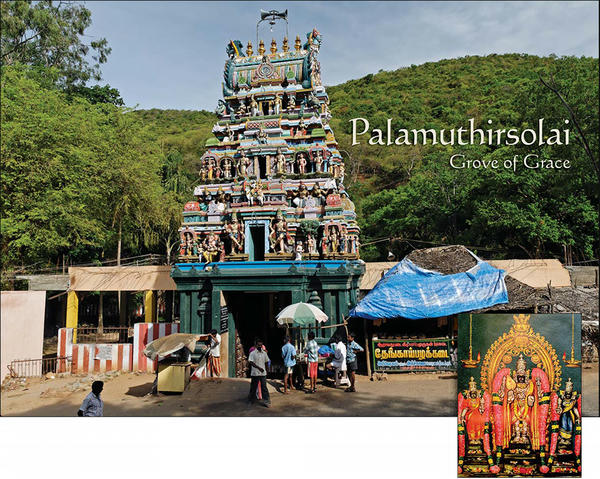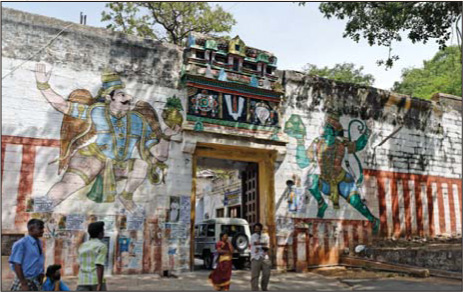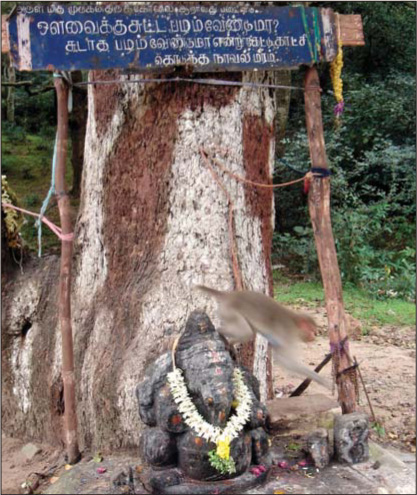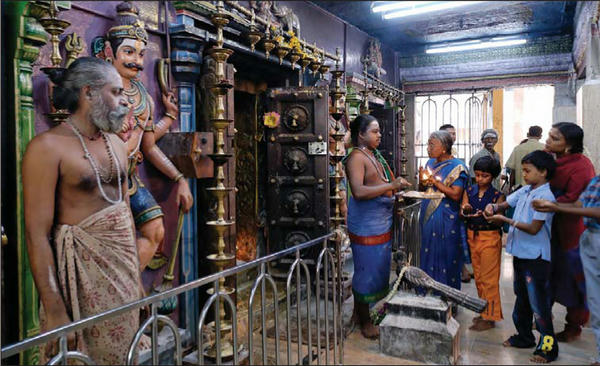

A. MANIVEL§
In the forest: The temple’s colorful entrance gopuram amid the forested hills; (inset) artist’s rendition of the main shrine
• • • • • • • • • • •§
 HE LAST LEG OF OUR PILGRIMAGE RETURNS US TO MADURAI, the nearest town to Palamuthirsolai, “grove of ripe fruit.” Trains, buses and flights go daily from Chennai back to Madurai. Once there, it is best to hire a car to get to the Palamuthirsolai Arulmigu Sri Subrahmanya Swami Tirukkoyil. Located 19 km north of the temple city in the Alagar Hills above the Alagarkoil of Lord Vishnu, it is the most remote and spartan of the arupadaiveedu.§
HE LAST LEG OF OUR PILGRIMAGE RETURNS US TO MADURAI, the nearest town to Palamuthirsolai, “grove of ripe fruit.” Trains, buses and flights go daily from Chennai back to Madurai. Once there, it is best to hire a car to get to the Palamuthirsolai Arulmigu Sri Subrahmanya Swami Tirukkoyil. Located 19 km north of the temple city in the Alagar Hills above the Alagarkoil of Lord Vishnu, it is the most remote and spartan of the arupadaiveedu.§
As we drive through the entry gate and head up the winding road, we are quickly enveloped in the clean, cool air of the thick forest. Soon we arrive at Lord Murugan’s sixth and final encampment. Says Vellayapettai Radhakrishnan for Murugan.org, “While this temple is not as large or bustling as the other five recognized shrines, it is just as incredible to visit. Even today the place is very fertile with many trees and different flora and fauna, a standing testimony to the vivid description of its natural beauty as found in Tirumurugarrupadai.” Though tranquil, the environs here are permeated with an electrical shakti that feels, to us, like an approaching lightening storm.§
There is a powerful sacredness here, owing to the three things the temple is famous for: a small stone vel; a Java Plum tree where Saint Auvaiyar met Lord Murugan; and a spring hailed in Saint Nakkirar’s poem as the source of Murugan’s grace on Earth.§

PHOTOS: M. AMIRTHAM/DINODIA§
The way to Palamuthirsolai takes one through the fortified wall of Alagarkoil
• • • • • • • • • • •§
Our guide is Sivasri Muthukumara Gurukkal, son of the chief priest. He tells us that, while the importance of this spot has been hailed for centuries, the temple that stands here now was constructed recently. “In ancient times, the vel was worshiped as the main Deity,” he explains, as he takes us to a shrine holding a stone vel just to the right of the main sanctum. “This vel is of great significance. It is the original Deity, and it is still highly venerated.” The lancelike vel wielded by Lord Karttikeya embodies discrimination and spiritual insight. Our Gurudeva, Satguru Sivaya Subramuniyaswami, wrote about the importance of Murugan’s vel in the lives of seekers on the spiritual path: “The shakti power of the vel, the eminent, intricate power of righteousness over wrongdoing, conquers confusion within the realms below. The holy vel, that when thrown always hits its mark and of itself returns to Karttikeya’s mighty hand, rewards us when righteousness prevails and becomes the kundalini serpent’s unleashed power thwarting our every effort with punishing remorse when we transgress dharma’s law. Thus, the holy vel is our release from ignorance into knowledge, our release from vanity into modesty, our release from sinfulness into purity through tapas. When we perform penance and beseech His blessing, this merciful God hurls His vel into the astral plane, piercing discordant sounds, colors and shapes, removing the mind’s darkness.” Pilgrimage is a penance of sorts, and the power of Murugan’s vel is felt throughout the arupadaiveedu. It is a force of change that remains with us, feeding and enriching our spiritual life for years to come.§
In this way have I known His graciousness, whether in these abodes or in other haunts. Wherever thou dost confront Him, be in tune to praise Him, your face in utter gladness beaming. Your hands uplifted above your head in worship, do thou prostrate yourself in surrender, full and fit, and in this manner raise thy voice of prayer:§
“Divine child with golden jewels bedecked, Thou art the refuge of those in anguish. Vanquisher with emblazoned chest exultant! Luminous Love, savior of the needy meek! Whose hallowed name the enlightened extol. Thou mighty conqueror who confoundeth titans, dauntless victor, Thou Supreme Lord Divine!”§
His immaculate form, majestic and mighty, divine in strength, and stature reaching skyward, manifests itself in sublime splendor. His fiery form instantly He conceals to one of genial youth and utters words of love: “Thy coming I know, fear thee not! Thou shalt surely excel in this world, girt by the furious oceans deep and vast, be thou One indeed, without a parallel.” Thus saying, He will grant everlasting worthy boons, rare indeed to attain by mortals weak.§
He is the Lord of the Mount from whose dizzy heights many a waterfall doth spin torrential falls—Lord of abundant fruit groves, too, where luscious fruits ripen.§
TIRUMURUGARRUPADAI, LINES 249-254, 271-276, 287-295, 315-317
TRANSLATED BY RATNA NAVARATNAM§

PHOTOS: M. AMIRTHAM/DINODIA§
Worshiping: A monkey frolics near Ganesha at the Java Plum tree
• • • • • • • • • • •§

PHOTOS: M. AMIRTHAM/DINODIA§
Sivasri Muthukumara Gurukkal shows worshipers the arati
• • • • • • • • • • •§
The Java Plum tree (Syzygium cumini or jambu) at Palamuthirsolai is the tree where Auvaiyar, a ninth-century saint, encountered Lord Balasubrahmanyam. The classic story relates that the elder woman sat under the shade of this tree to rest on the way to the temple. A boy called out from the branches above and asked her if she would like some hot or cold fruit. Perplexed but curious, she asked for the former. The boy shook the tree, and some of the grape-sized plums fell from its branches onto the sand below. Picking one up, she blew on it to clean off the sand. The boy chortled and asked if she was blowing on the fruit because it was too hot. Only when she entered the temple did she realize that she had just met Lord Murugan Himself, and that she actually didn’t know as much as she thought she did. Through His simple play, Murugan shattered her arrogance. Auvaiyar went on to write some of the sweetest, most celebrated Tamil devotional songs. It is considered a miracle that this tree fruits every year during the six-day Skanda Shashthi festival in October-November, completely off season.§
To Saint Nakkirar, the spring above Palamuthirsolai is the waterfall of grace that showers the devotee who reaches the final stop on this profound inner odyssey. The water from this spring is said to have healing qualities. Devotees flock there, filling up bottles to take home with them, bringing them first to the temple for blessings.§
Today, the central shrine houses a small, standing murti of Lord Murugan, with consorts Valli and Devayanai at His sides. As we sit watching the abhishekam, the image of Lord Murugan’s grace as the waterfall comes to the mind’s eye. The joy of completion pours over us. Inwardly quiet, blissfully content, we feel we have accomplished something special. It is an inner fulfillment, arrived at after an outer journey.§
For centuries, seekers who have performed this noble pilgrimage have testified that at its end awaits a release from the worries and concerns of their lives. They are relieved of things long burdening their hearts and minds, never to be plagued by them again. This real-life purifying experience is captured in the Vedas, which affirm, “To such a one who has his stains wiped away, the venerable Sanatkumara shows the further shore of darkness. Him they call Skanda.”§